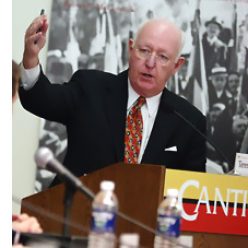With a splendid second inauguration behind him, Barack Obama sits down at his desk this morning to grapple with a huge agenda of problems and opportunities, challenges and openings, dangers and adventures at home and abroad.
“America’s possibilities are limitless,” the President proclaimed yesterday beneath a blue sky and bright sun, “for we possess all the qualities that this world without boundaries demands: youth and drive, diversity and openness, an endless capacity for risk and a gift for reinvention.”
We will need all of that and more, and so will he.
Speaking from the West Front of the Capitol, the President sounded like the most confident lame duck in recent memory (think George W. confronting the morass in Iraq, Bill Clinton already tempted by Monica, Ronald Reagan, tiring and already embroiled in the early stages of Iran-Contra.) Obama was unapologetic about his agenda, from immigration reform to gay rights, and once again invited Congressional Republicans to join him in pursuing it. The GOP Speaker of the House, John Boehner, squinted into the sun with a sour look. The contrast between the two men spoke volumes.
Looking back over the last six months or so, say, since the nomination of Mitt Romney, the most striking development in American politics is not the re-election of the President or the relative status quo in Congress, it is the virtual disintegration of the Republican Party.
Who leads that party today and what does it stand for?
Is it Boehner, who cannot control his own caucus? Is it Senator Mitch McConnell, who sat expressionless in the crowd of faces behind the President yesterday? Four years ago, he laid down a marker by declaring his number one objective to be confining President Obama to a single term.
Is it Eric Cantor, who looked none too happy himself on the dais? Is it the Tea Party, with its response of “No” to virtually everything the President proposes?
What does the GOP stand for? Smaller government, yes; reduced debt, yes. But is less really more? Is it an answer to persistent unemployment and sluggish growth? To persistent challenges abroad? What is the affirmative Republican strategy and who will articulate it, not just now but in the run-up to 2016? Paul Ryan? Marco Rubio? Who will reach out to an increasingly diverse America?
Never have there been so many unanswered questions about the policies and future of a major American political party.
And yet, history illustrates that political fortunes are cyclical, that a party that reaches its nadir will come back up, that politics abhors a vacuum. Republicans remain powerful in statehouses, especially in the south and southwest, and their financial backers are far from tapped out. So the status quo will change.
But it is hard, in the first full week of a new Presidential term, to see when and how and who will lead that change.
